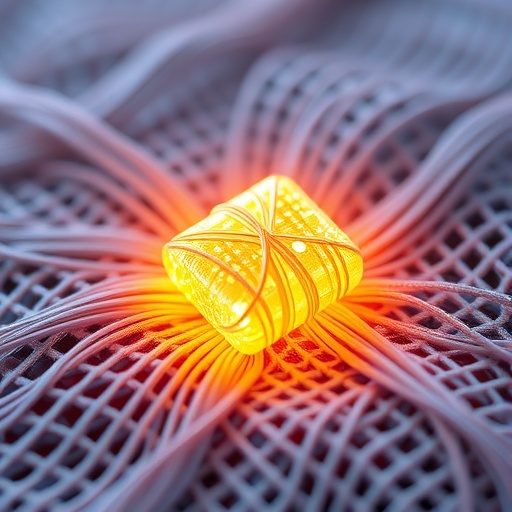The advancement of wearable electronics stands as one of the most transformative changes in technology over recent years. As consumers seek more integrated experiences in their daily lives, the demand for power sources that can seamlessly blend with textiles while maintaining stable and reliable outputs during varied activities has surged. Traditional rigid power sources often fall short because their inflexibility makes them uncomfortable during physical exercise, thus challenging the design and functionality of wearable systems. This context sets the stage for groundbreaking innovations in energy solutions designed specifically for the future of wearable devices.
In a display of ingenuity, researchers from the School of Materials & Energy at Southwest University have developed a revolutionary stretchable sweat-activated yarn battery, aptly named the S-SAYB. The S-SAYB has the remarkable ability to deliver ultra-stable power output even when subjected to stretching and other mechanical deformations. With a focus on maintaining both performance and comfort, this innovation could redefine how we power wearable electronics.
The design of the S-SAYB possesses a dual approach that integrates stretchability with output stability—two characteristics often at odds in traditional systems. As noted by Prof. Zhisong Lu, a senior author involved in the research, the creation of such a battery effectively addresses a long-standing challenge faced by manufacturers and researchers in developing wearable and stretchable power sources. The design incorporates elastic fibers enveloped in a hydrophilic layer, an essential feature that retains electrolytes necessary for ion movement. This clever strategy ensures that, even during significant stretching, the battery maintains its operational capabilities.
Further enhancing the S-SAYB’s performance, the researchers adopted a high electrode wrapping density. This approach minimizes the distance between electrodes, thus significantly expanding the pathways available for ion migration. In simpler terms, this means that even when users engage in strenuous activities, the battery performs reliably, ensuring that essential devices remain powered throughout.
S-SAYBs also have the potential for large-scale production. The team developed a specialized wrapping machine that enables meter-scale manufacturing, allowing for the battery to be seamlessly integrated into various electronic textiles. Traditional techniques such as weaving, knitting, sewing, and stitching can effectively incorporate these batteries into everyday attire. In trials, the batteries have been successfully integrated into items such as headbands and sports t-shirts, showcasing their flexibility and the ease with which they provide dependable power to wearable electronic devices during physical activities.
Safety and biocompatibility remain paramount in the design of wearable technology. Given that the S-SAYBs are intended for contact with human skin, their compatibility with human biology is critical. Prof. Lu confirmed that on-skin tests indicate the S-SAYBs can be safely embedded into textiles that will contact the skin, mitigating any health risks while providing sustainable energy solutions. This aspect is vital not only for increasing user confidence but also for integrating the technology into health-monitoring devices that may track various physiological metrics during sports or fitness workouts.
As research progresses, the team plans to explore the integration of their stretchable batteries with a wider variety of electronic devices. The objective is to expand the functionality of wearables, moving beyond mere energy provision to include intelligent systems capable of multifunctional operations. This could mean blending health monitoring, environmental sensing, and communication capabilities in a single electronic textile, elevating the utility of wearable devices substantially.
The implications of the S-SAYB technology stretch beyond mere convenience. Its successful application could pave the way for advanced health-monitoring apparel that operates continuously and accurately during any physical activity. As the world increasingly embraces smart solutions and digital health tracking, the importance of reliable, integrated power sources cannot be overstated. This research not only contributes to the battery technology space but also serves as a significant step toward the development of the next generation of wearable electronics.
By addressing both performance and comfort, the S-SAYB could change the narrative surrounding wearable technology, leading to a more user-friendly experience. As consumers become more health-conscious and engaged in fitness, the demand for such innovations will only continue to grow. The ability of these batteries to offer strain-insensitive power output makes them a compelling choice for applications in sports and health-related wearables.
Moreover, innovations like the S-SAYB reflect a broader trend within materials science, where researchers are increasingly focusing on developing technologies that are not only efficient but also sustainable. The use of biodegradable materials, along with the energy-efficient design of power sources, aligns with global efforts to create environmentally friendly technologies. This is an essential consideration as society continues striving for solutions that meet both technological and ecological responsibilities.
In summary, the development of the stretchable sweat-activated yarn battery represents a significant leap forward in the field of wearable electronics. As the demand for seamless, comfortable, and effective power sources rises, the S-SAYB stands poised to meet this need with a promising fusion of technology and human-centric design.
The future of wearable electronics has never looked more secure with such innovative power solutions on the horizon, and it will be exciting to see how the integration of these technologies evolves in the coming years.
Subject of Research: People
Article Title: Stretchable sweat-activated yarn batteries with strain-insensitive power output for textile electronics.
News Publication Date: [Publication Date Not Provided]
Web References: [Web References Not Provided]
References: [References Not Provided]
Image Credits: Credit: D. Li, et al.
Keywords
Wearable technology, stretchable batteries, energy solutions, electronic textiles, biocompatibility, advanced materials, sweat-activated devices, innovative designs, smart wearables.




